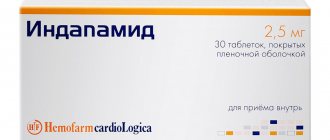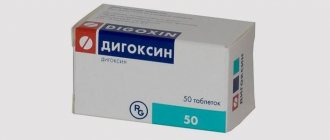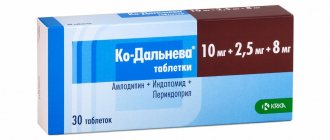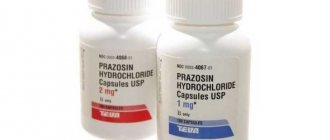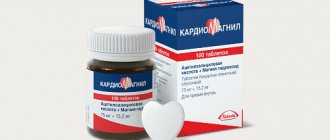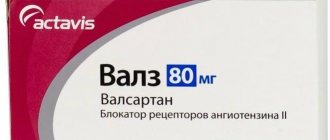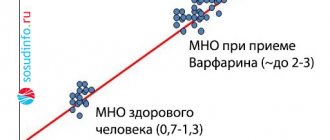Composition and release form
Blood pressure medicine Andipal is available in tablet form, convenient for dosing and use. The composition of Andipal tablets includes several active components, providing its wide range of applications:
- Papaverine - 0.02 g;
- Sodium metamizole - 0.25 g;
- Bendazole - 0.02 g;
- Phenobarbital - 0.02 g.
All ingredients complement and enhance each other’s effects, guaranteeing a pronounced synergistic effect and versatility of the drug.
The drug is sold in packages containing 10, 30 or 100 tablets.
Andipal packaging
Interaction of Andipal with other drugs
Combined use of the drug with nitrates (Nitrosorbide, Nitroglycerin, Sustak), beta-blockers (talinolol, oxprenolol, metoprolol), amiodarone, CCB (Corinfar, Nifedipine), diuretics (Hypothiazide, Furosemide), ginglioblockers (pentamine), myotropic antispasmodics (eufillin, dipyridamole) causes an increase in the hypotensive effect of Andipal.
The combination of Andipal with direct and indirect adrenergic agonists, analeptics, and n-cholinomimetics reduces its hypotensive effect.
Pharmacological characteristics: increases or decreases blood pressure
Anti-pressure tablets Andipal belong to the group of non-narcotic analgesics. Despite the fact that the drug does not eliminate the root causes of the disease and does not treat hypertension, Andipal quickly reduces blood pressure, providing a powerful antihypertensive effect.
The medicine is characterized by the presence of the following therapeutic properties:
- Antispasmodic effect;
- Analgesic effect;
- Vasoconstrictor properties.
Andipal helps eliminate spasms of vascular muscles and relieve pain characteristic of hypertension.
Andipal acts quickly, and therefore the maximum concentration of the active ingredients of the drug in the patient’s blood is observed already 25-30 minutes after consuming the tablets.
Most of the drug is transformed into liver metabolites. The remaining medicine is excreted from the body through the kidneys along with urine.
An important advantage is the fact that the drug not only normalizes blood pressure, but also helps eliminate headaches and other symptoms of hypertension, improving the person’s condition as a whole.
What is Andipal
Andipal belongs to the group of combined drugs that combine the properties of an antispasmodic, analgesic, sedative, and vasodilator. It serves as a good remedy for the treatment of the early stages of hypertension; it reduces pressure due to analgesia and relaxation of the walls of blood vessels. Andipal for pressure is available in white or yellowish tablets, each package contains several blisters of 10, 20, 30 pieces.
Andipal increases or decreases blood pressure
The basis of the drug consists of four components that are combined with each other. After using the medicine according to the instructions, the level of calcium in the cells decreases, the blood vessels relax, the tone disappears, the pressure decreases, so doctors consider Andipal an effective remedy for hypertension. In addition to the hypotonic effect, the tablets have analgesic and sedative properties.
The drug relieves symptoms associated with hypertension in the form of headaches and rapid heartbeat, and alleviates the general condition of the patient. However, Andipal is not a complete medicine used for the treatment and prevention of cardiovascular diseases. The remedy only alleviates the painful symptoms that bother you during a hypertensive crisis.
What is Andipal prescribed for?
Therapists and cardiologists recommend taking Andipal for high blood pressure in patients with the following clinical indications:
- Arterial hypertension;
- Encephalopathy;
- Hypertonic disease;
- Painful sensations localized in the visual organs;
- Headache;
- Disorders of urination processes;
- Retrosternal pain;
- Migraine attacks;
- Spasms of cerebral and peripheral vessels;
- Cervical artery syndrome.
Andipal for high blood pressure and hypertension is prescribed as a component of a complex therapeutic course in order to eliminate painful symptoms.
For hypertension, Andipal is prescribed as part of complex therapy
Indications for use
The drug Andipal is used as an analgesic to relieve pain due to vascular spasms. Andipal is recommended to be taken in the following cases:
- eye pain.
- urinary disorders.
- primary arterial hypertension.
- increased intracranial pressure.
- hypertensive diseases.
- encephalopathy.
- headaches, incl. after suffering injuries.
- chest pain, etc.
Contraindications to taking the medicine
Andipal tablets, which lower blood pressure, should not be used by people who have the following clinical contraindications:
- Intestinal obstruction;
- Liver dysfunction;
- Glaucoma;
- Individual intolerance and hypersensitivity to the ingredients contained in the drug;
- Liver porphyria;
- Disturbances in the functioning of the circulatory system;
- Severe angina pectoris;
- Prostatic hyperplasia in men;
- Bradycardia (slow heart rate);
- Impaired renal function;
- Heart failure occurring in the decompensation stage;
- Myasthenia;
- Blood pathologies.
Andipal for reducing blood pressure is also contraindicated in young patients under the age of majority!
Contraindications
There is no need to be deluded by the low cost and availability without a specialist prescription.
Andipal helps with pain and spasms, with high blood pressure, but such a wide scope of application and rich composition have a downside.
There are many side effects and many situations where use is unacceptable.
Among the contraindications:
- Acute intestinal obstruction. Several types. In the first case, a critical spasm of the walls of a hollow organ is observed. Using it will only make things worse.
In the second, the lumen is blocked by a foreign object, a tumor. Then using Andipal is deadly.
Under the influence of the drug, muscle tone will decrease and motor skills will increase. This will dislodge the foreign object and may cause the blockage to worsen.
It will most likely end with intestinal rupture, peritonitis and the death of the patient.
- Individual intolerance to the components of the drug. Main and auxiliary. Because it is possible to be allergic to the components. How strong it is depends on the case and the characteristics of the body.
Multiple drug intolerance is much less common. It involves an immune response to a whole group of drugs.
You can only determine by trial, you need to be careful. Another name is polyvalent allergic reaction.
- Benign prostatic hyperplasia. Previously - prostate adenoma. Andipal causes relaxation of the smooth muscles of the urethra and bladder neck, which can be dangerous in advanced cases and will provoke a paradoxical response, an acute delay in the passage of urine.
- Pregnancy regardless of stage. It has been proven that analgin and other components affect the fetus, its physical development and the state of the central nervous system. Spontaneous deviations, defects, and death inside the womb are possible.
- Lactation. Breast-feeding. The active substances penetrate into the milk and are passed on to the baby. This is extremely dangerous.
- Children's age up to 8 years. Use earlier has not been studied. Therefore, there is no data on safety and effectiveness.
- Disruption of the hematopoiesis process as a result of hematological diseases. Andipal can aggravate the condition of patients.
- Tachycardia against the background of other forms of arrhythmia. Parallel flow. The development of a critical fall in heart rate and the death of the patient is possible.
- Severe heart failure with low myocardial contractile function. A decrease in vascular tone in this case will have a negative effect. As does lowering blood pressure. Because the muscular organ will experience a deficiency of oxygen and nutrients against the backdrop of an even greater disruption of pumping function and the volume of incoming blood.
- Severe forms of angina (coronary insufficiency). In which the heart receives few useful compounds. This is a risk factor for an early heart attack.
- Comatose or collapsed state.
- Glaucoma. Increase in intraocular pressure. Absolute contraindication.
- Kidney or liver failure, regardless of the phase of the pathological process. Even with compensation with drugs and no violations during the treatment.
Prescribing the drug is possible only taking into account the indications for use; unreasonably often resorting to it is unacceptable.
Attention:
The medicine is controversial in terms of its appropriate use. In the vast majority of cases, the best solution will be to prescribe several specialized medications in controlled dosages.
This allows you to more accurately vary the treatment regimen. Gives the doctor more freedom and makes treatment flexible.
Here lies the main disadvantage of mixed, combined products. There are very few situations where Andipal can be called the best drug.
How to take Andipal for blood pressure and hypertension
Instructions for use Andipal recommends starting therapy with a minimum amount of the drug, 1 tablet per day.
If, in addition to high blood pressure (BP), the patient is bothered by headaches and vascular disorders, the daily dosage of Andipal can be increased to 2 tablets. The maximum permissible dose of the drug should not exceed 5 tablets taken throughout the day.
The average positive effect of the therapeutic course is 1-1.5 weeks. However, the exact decision regarding how long to drink Andipal is made by a qualified specialist on an individual basis, depending on the diagnosis, the body’s reactions to the proposed treatment and other features of a particular clinical case.
Andipal: instructions for use
Proper use of Andipal tablets helps to quickly eliminate spasms and pain. But for Andipal tablets, the instructions for use indicate that it is necessary to wisely choose the moment to take the drug. If certain important aspects are not taken into account, there is a danger of harming your well-being. Therefore, it is necessary to consider in detail how this drug should be taken. Such requirements deserve the greatest attention.
- The recommended method is a single use of one or two Andipal tablets, provided that severe pain is observed or a slight increase in pressure is detected. That is, it is not recommended to use the drug for prevention and without obvious symptoms. Moreover, you should not take this remedy for a long time, since then there is a danger of side effects.
- Only on the recommendation of a doctor is it possible to take pills for several days in a row. But still, the course is limited to a period of 7-10 days. After this there should be a break of at least a month.
- It is best to take the tablets with food. At the very least, it is not advisable to use Andipal on an empty stomach. The effect of the drug will be most safe if it is taken with light or liquid food. Approximately 10 minutes after eating, the tablets themselves are taken.
- With long-term use (within the recommended norm), the dosage can reach 4 tablets per day, but no more. There are two approaches to choosing the frequency of administration. The first option is 1 tablet three times a day. The second method is 2 tablets twice a day. This dosage is intended for adults only. This drug is not recommended for children at all.
- Separately, it should be said about taking Andipal together with other medications. These tablets can only be used if other analgesics, painkillers and antispasmodics are not used. It is not advisable to combine Andipal with medications that have anti-inflammatory properties. Tonic drugs and barbiturates can reduce the effectiveness of Andipal.
As you can see, there are many restrictions when taking Andipal. But all of them must be taken into account, since otherwise side consequences simply cannot be avoided. It is also worthwhile to find out separately what instructions for use are given on Andipal for high blood pressure. Still, as is now clear, elevated blood pressure is not always an indicator for the use of such a drug.
Andipal for high blood pressure
The method of using the tablets in this case is determined by what causes the increase in pressure. There are two main options here. To choose a specific one, you need to consider the following.
- If the increase in pressure is caused by some external factors and is situational in nature, you need to take just one tablet of the drug. After this, you cannot take Andipal. But, as mentioned above, these tablets only help with slightly elevated blood pressure. When systolic pressure jumps above 160 points, it is necessary to use other drugs.
- For chronic hypertension, the use of Andipal is not recommended. Only if prescribed by a doctor, you can take 2-3 tablets per day for a maximum of five days. After this, Andipal should be replaced with another drug.
Once again, you should be warned about the side effects that appear with long-term use of Andipal. It is because of them that the drug is not recommended for long-term use in the first place. Also, we must not forget about the contraindications, which are quite numerous for this drug.
special instructions
Andipal lowers blood pressure quickly and effectively, but this drug is not suitable for long-term treatment. Since the medication contains phenobarbital, there is a high probability of the body becoming accustomed to it and developing drug dependence.
Tablets are taken in short courses
Practice shows that users are able to lower their blood pressure with Andipal tablets literally within a few days. If it was not possible to achieve the desired result, you should consult a doctor regarding the selection of a more suitable analogue.
Despite the fact that minor age is a contraindication to the use of tablets, in exceptional cases, experts prescribe Andipal to children and adolescents. Treatment of young patients is carried out under strict medical supervision and involves significantly lower dosages of the drug than those recommended for adults.
Indications
Doctors prescribe Andipal for:
- primary and secondary types of hypertension. The tablets, according to pharmacists, are good for lowering blood pressure;
- dysuria;
- migraine;
- gastritis;
- algodismenorrhea;
- mild angina;
- bronchospasm;
- damage to the trigeminal nerve;
- pain syndrome, which is caused by spasms of smooth muscles and internal organs of the digestive tract. For example, if the patient has hepatic, renal or biliary colic, intestinal spasms, colitis;
- high intracranial pressure;
- atypical facial pain;
- pain caused by spasms of cerebral vessels;
- headaches after injury;
- spasms in the bladder, ureter;
- increased anxiety.
In medical practice, for non-spasmodic pain and high fever, Andipal is rarely used due to its low effectiveness. If the pain is caused by inflammation, the tablets can reduce it slightly due to their anti-inflammatory effect.
Although hypertension is indicated in the instructions as an indication for use, Andipal is used extremely rarely as an antihypertensive agent.
This is due to the fact that the hypotensive effect of the drug is weak and manifests itself rather slowly. In this case, the drug must be taken for longer than 10 days to achieve the desired effect.
In addition, the product can cause a short-term increase in tonometer readings. This is explained by the presence of dibazole in the composition, which slightly increases vascular tone. Which is fraught with a stroke. But after a few minutes, the blood vessels relax, and the pressure begins to decrease.
Therefore, this medication is used primarily to relieve headaches. To lower blood pressure, it should be combined with other antihypertensive medications. It is better to use Andipal when a person does not suffer from hypertension, with a one-time sharp increase in blood pressure.
There have been cases when this drug helped hypotensive patients stabilize their tonometer readings.
It should be noted that Andipal is often prescribed to pregnant women for high blood pressure. Indeed, compared to a number of other antihypertensive drugs, these tablets are less harmful.
In addition to the indications, there are also contraindications to the use of the drug and side effects of the drug. And they need to be taken into account before you start taking it.
Andipal during pregnancy and lactation
Treatment with Andipal tablets is strictly contraindicated for pregnant and breastfeeding women! The drug has an extremely negative effect on the body of the unborn baby, leads to congenital brain pathologies, and also increases the likelihood of the child developing cerebral palsy.
Since the ingredients of the drug tend to pass into breast milk, during lactation it is necessary to either stop therapy or transfer the baby to artificial feeding.
Side effects of Andipal
The following side effects may occur as a result of taking Andipal:
- allergic reactions (up to anaphylactic shock);
- constipation;
- nausea.
Long-term use of the drug, due to the presence of analgin in it, can have a depressing effect on the blood, causing leukopenia, thrombocytopenia, and agranulocytosis.
Andipal contains phenobarbital, which has a sedative effect on the body and can in some cases cause depression and ataxia, especially in elderly patients.
Side effects
The use of Andipal for high blood pressure may cause the following adverse reactions:
- Stool disorders (diarrhea followed by constipation);
- Nausea;
- Attacks of vomiting;
- Depressive state;
- Allergic rashes on the skin;
- Lethargy, drowsiness, apathy, general malaise and decreased ability to work;
- Disturbances in the functioning of the digestive system.
If side effects occur, you should stop using the tablets and seek help from a specialist to adjust the dosage or select a more suitable analogue.
Purpose
Andipal is used to relieve pain during spasms of smooth muscles of the gastrointestinal tract, moderate spasms of cerebral vessels, as well as peripheral vessels. In particular, it is prescribed for migraines and mild forms of hypertension. In addition, Andipal is also used for other ailments, for example, for mild colds.
Andipal has analgesic, antispasmodic and vasodilating effects
Thus, after taking the pill, headaches and even menstrual pain go away, abdominal cramps disappear, and blood pressure decreases due to relaxation of the walls of blood vessels.
Overdose of Andipal
Use of the drug in large dosages exceeding the permissible norm is likely to result in the following painful symptoms:
- Muscle weakness;
- Attacks of severe dizziness;
- Excessively low blood pressure;
- Increased sleepiness.
With such a clinical picture, it is necessary to perform a gastric lavage on the patient, inducing artificial vomiting, and allow him to take sorbents. Further treatment of overdose is symptomatic and is prescribed by the doctor on an individual basis.
Overdose can cause severe dizziness
Effect of the drug
Metamizole sodium, which everyone knows as analgin, is a well-known broad-spectrum pain reliever, as well as an anti-inflammatory and antipyretic.
Diabazole and papaverine hydrochloride are myotropic antispasmodics. They reduce the tone of the smooth muscles of blood vessels and internal organs, and also have a vasodilator and analgesic effect. Thus, these components help improve collateral circulation, which occurs through the lateral branches, bypassing the main highways, and also reduce pressure.
Phenobarbital has a sedative effect. It calms and relieves excessive nervous tension.
Thus, Andipal can be considered an analgesic, antispasmodic, vasodilator, sedative and antipyretic.
The combination of analgin with myotropic antispasmodics enhances the analgesic effect for migraines and other types of headaches. Phenobarbital also enhances the actions of other components.
Drug interactions
The combination of the drug Andipal with diuretics, nitrates, antispasmodics, adrenergic blockers and calcium channel blockers enhances the hypotensive effect of the tablets, which threatens a hypotensive crisis.
When combined with tonic drugs, analeptic and anticholinesterase drugs, adrenergic receptor agonists, the ability of the tablets to reduce blood pressure is significantly reduced.
Andipal has poor compatibility with activated carbon, since sorbents prevent the penetration of the active substances of the drug into the gastrointestinal tract and their further absorption by the body.
Video on the topic
How to take Andipal correctly? How quickly does this drug reduce blood pressure? Answers in the video:
Thus, different medications are sold in pharmacies to relieve pain, spasms and lower blood pressure. Many doctors prescribe combination drugs. Andipal is considered an effective and safe remedy. It works after just a quarter of an hour and relieves unpleasant symptoms for about six hours.
The information on the MyMedNews.ru website is for reference and general information, collected from publicly available sources and cannot serve as a basis for making a decision on the use of medications in the course of treatment.
MyMedNews.ru
And we also have
Reducing blood pressure in diabetes - what tablets can be used?
What can be replaced
The following analogues of Andipal are presented on the modern pharmaceutical market:
- Analdim;
- Urolesan;
- Quatrox;
- Unispaz;
- Captopril.
The drug Andipal is an effective remedy that allows you to quickly get rid of high blood pressure, headaches and other manifestations of hypertension. Since the tablets contain narcotic components (phenobarbital), they can only be taken as prescribed by a doctor, without exceeding the recommended dosage and duration of treatment!
Analogs
In accordance with the active ingredients, Andipal has no analogues. But there are the following analogues of Andipal, which have a similar effect on the body:
- Urolesan.
- Papazol-UBF.
- Unispaz.
- Captopril.
- Analdim.
- Quatrox and others.
Captopril Analdim
Papazole Urolesan Unispaz
Before replacing Andipal with an analogue, you should consult a doctor for possible adjustment of the prescribed dose and to avoid side effects of the drug.
Analogues of the drug
Synonyms for the antispasmodic effect of the drug “Andipal” are:
- "Theodibaverin"
- "Nomigren";
- "Urolesan";
- "No-spalgin";
- Unispaz;
- "Papazol."
1. Analgin. The drug blocks nerve endings, thereby eliminating pain during:
- neuralgia;
- headache;
- muscle pain;
It is also used in complex therapy after surgical interventions. Analgin consists of: phenyl, dimethyl, methylaminopyrazolone and sodium methanesulfonate. The cost of Analgin is approximately 15 rubles.
2. Papazol. The medicinal product consists of:
- dibazole;
- papaverine hydrochloride
- excipients (potato starch, talc, calcium stearate).
Papazol is used as an independent drug or in addition to others, for hypertension, vascular spasms, spastic colitis, facial paralysis. The cost of this drug is 14 rubles.
3. Captopril. One tablet contains captopril and excipients (lactose monohydrate, microcrystalline cellulose, potato starch and magnesium stearate). Indications for use:
- arterial hypertension;
- complex for heart failure;
- diabetic nephropathy.
The approximate cost is 10 rubles.
Andipal is effective for high blood pressure, but this drug must be used with great caution. If you have any heart pathologies, you should stop taking this medication. Experts have noticed that the drug affects the nervous system and can provoke depression. Also, during the treatment period, lethargy and decreased activity are observed.
How the drug works
The instructions for use indicate that the medication has an antispasmodic and anesthetic effect, and the blood pressure decreases. Long-term practice of use shows that as a result of taking the drug, an effect is achieved that relaxes the walls of veins and arteries, expanding their internal cavity. The medicine reduces the excitability of the neuromuscular system and brain activity.
The mechanism of action of the drug is determined by the components contained in each tablet.
- Analgin - has a pronounced analgesic effect. Relieves heaviness and pulsation in the head, caused by high blood pressure, eliminates hyperthermia. When used, the sensation of heat in the face and neck also disappears, which often worries hypertensive patients.
- Dibazol – has a vasodilating effect. As a result of use, the lumen of the blood vessels becomes wider, and the intensity of the blood pressure in them is lower, making the transmission of nerve impulses easier. Thanks to this component, the drug tablets reduce blood pressure by several units.
- Papaverine is a substance included in the list of drugs for spasms. The component relieves strong tone of the vascular wall, normalizes blood circulation, and has a slight hypotensive effect.
- Phenobarbital - reduces blood pressure due to the rapid achievement of sedation. The substance calms and stabilizes the psycho-emotional state, regulates the functioning of the nervous system, and helps enhance the effect of other substances.
The drug also contains minor ingredients that do not have a pharmacological effect on the patient’s body. They are necessary to bind the main components and obtain the appropriate release form of the drug.
Is it possible to drink Andipal at low blood pressure?
To understand whether andipal increases or decreases blood pressure, you need to consider its composition and the effect that each component has.
Composition of the drug
Andipal is a complex drug, which means that it affects several organs or systems simultaneously. It contains the following active substances:
Effect of the drug
Metamizole sodium, which everyone knows as analgin, is a well-known broad-spectrum pain reliever, as well as an anti-inflammatory and antipyretic.
Diabazole and papaverine hydrochloride are myotropic antispasmodics. They reduce the tone of the smooth muscles of blood vessels and internal organs, and also have a vasodilator and analgesic effect. Thus, these components help improve collateral circulation, which occurs through the lateral branches, bypassing the main highways, and also reduce pressure.
Phenobarbital has a sedative effect. It calms and relieves excessive nervous tension.
Thus, Andipal can be considered an analgesic, antispasmodic, vasodilator, sedative and antipyretic.
The combination of analgin with myotropic antispasmodics enhances the analgesic effect for migraines and other types of headaches. Phenobarbital also enhances the actions of other components.
Purpose
Andipal is used to relieve pain during spasms of smooth muscles of the gastrointestinal tract, moderate spasms of cerebral vessels, as well as peripheral vessels. In particular, it is prescribed for migraines and mild forms of hypertension. In addition, Andipal is also used for other ailments, for example, for mild colds.
Thus, after taking the pill, headaches and even menstrual pain go away, abdominal cramps disappear, and blood pressure decreases due to relaxation of the walls of blood vessels.
Andipal for hypertension
The drug is not suitable for everyone suffering from arterial hypertension. To reduce blood pressure, it is prescribed only in cases of mild hypertension or in the initial stage of the disease, when there are no sudden and frequent changes in pressure.
The drug is indicated for patients with a short-term increase in blood pressure, the level of which does not exceed 150/90 mm Hg. pillar As a rule, Andipal is prescribed if the increase in pressure is caused by vasospasm.
If hypertension is not associated with increased vascular tone, this drug is not recommended.
It should also be said that in the initial stage of hypertension, constant use of Andipal is excluded. The doctor may prescribe the drug for a short course or occasionally - one tablet and only if blood pressure increases. For hypertension, Andipal not only helps reduce blood pressure, but also relieves headaches and also has a mild sedative effect.
Andipal for hypotension
Is it possible to take Andipal with low blood pressure? There is an opinion that if you have low blood pressure, it is undesirable to use the drug or should be discussed with your doctor, since this medication can increase the symptoms of hypotension and lead to disturbances in brain function.
Warning
You should not take Andipal uncontrollably, much less regularly, if you experience pain or high blood pressure that is not persistent and constant. These conditions may have different origins, and this remedy may simply not be suitable. For any ailments, diagnosis is required, and treatment must be prescribed by a doctor.
Inga - November 30, 2014 - 19:32
I haven’t tried this remedy, but I know for sure that royal jelly balances blood pressure well. This is a very valuable beekeeping product. Recently I myself experienced hypotension, weakness and strong sweating appeared. I was just recommended to suck on Apilak and I really felt better. Weakness gave way to energy, profuse sweating stopped, and overall I felt better.
Irina — October 29, 2020 — 18:45
I drank citramon - my blood pressure increased to 150/90. Is it possible to drink Andipal?
Irina — January 2, 2020 — 00:54
Andipal - The best, with a magical effect, and very affordable! I always have it in my cosmetic bag, in the pocket of my purse, as an ambulance for stress expressed by headaches, toothaches and any other cramps. I found out about him completely by accident. At 38 years old, I was under serious stress at work and suddenly began to have a headache.
A close friend recommended that you under no circumstances endure a headache, but immediately drink a quarter of the tablet. All you had to do was drink once and the pain instantly disappeared, and your brain and entire body simply surprised you with strength, calmness and health! The stress passed, and the pills remained in my arsenal with gratitude.
Now more than 15 years have passed and the tablets have never failed. My friends and my adult children now use them. Helps everyone! One blister of 10 tablets lasts me more than a year, despite the fact that I usually give tablets to help someone around me.
They not only immediately relieve pain, but also soothe, and if consumed during pain, for example in the evening of a toothache, they gently put you to sleep, relieving inflammation and pain. If necessary, you can take half, and in a serious case, a whole tablet, and for some, more. think for yourself. The cost is about 8 rubles.
Some of my friends say that they replaced No-shpa with Andipal, as it is more effective and softer. I haven't used it, so I can't compare.
Guest — November 26, 2020 — 19:51
Is it possible to take Andipal with high blood pressure and low heart rate?
Pressure and everything about it
Source: https://pro-serdze.ru/lechenie/mozhno-li-pit-pri-nizkom-davlenii-andipal.html
